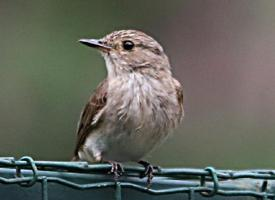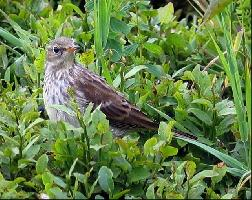
Poids et mesures
| Longueur | de 14 à 15 cm |
|---|---|
| Poids | de 18 à 20 g |
| Envergure des ailes | de 22 à 25 cm |
Description de l'animal
The Meadow Pipit (Anthus pratensis) is a small passerine bird that is a member of the pipit family. It is widely distributed across the Palearctic region, encompassing much of Europe and Asia, and extending into the Arctic. This bird is particularly known for its affinity for open landscapes such as meadows, moorlands, and tundra, where it can be seen walking with a characteristic bobbing motion.Physically, the Meadow Pipit is a slender bird, measuring about 14-16 cm in length, with a wingspan of 22-25 cm. It weighs between 15-22 grams. The plumage of this bird is predominantly a mixture of brown and black tones, which provides excellent camouflage against the ground. Its upperparts are streaked with dark brown, while the underparts are paler with thin, dark streaks. The bird has a pointed bill, which is perfectly adapted for its insectivorous diet, although it also consumes seeds.
One of the most distinctive features of the Meadow Pipit is its flight pattern. When flushed, it exhibits a characteristic 'parachute' descent, with legs dangling, which is different from the more direct flight of other pipit species. During the breeding season, the male performs a captivating display flight, rising high into the air before spiraling back down to the ground while singing a series of melodious trills and chirps.
The Meadow Pipit is a ground-nesting bird, with the female constructing a well-hidden nest in a hollow on the ground, often among tall grasses or under a tuft of vegetation. The nest is made of grass and lined with finer materials. The female lays and incubates a clutch of 3-5 eggs, which are pale and speckled, blending well with the surrounding environment. Both parents are involved in feeding the chicks, which fledge about two weeks after hatching.
In terms of migration, Meadow Pipits exhibit a range of behaviors. While populations in the northern parts of its range tend to migrate southwards to escape the harsh winter, those in milder regions may be resident or perform only short-distance movements.
Despite facing threats from habitat loss and degradation, especially in areas where intensive agriculture has taken over natural landscapes, the Meadow Pipit is currently listed as Least Concern by the IUCN Red List, thanks to its wide distribution and large population. However, continued monitoring and conservation efforts are necessary to ensure that this species remains a common sight in its natural habitats.
The Meadow Pipit plays a crucial role in the ecosystem as both a predator of insects and as prey for larger birds. Its presence indicates healthy, biodiverse environments, making it an important species for conservationists and bird watchers alike.
Animaux similaires
Nouvelles photos d'animaux
Top 10 des animaux
- Dolphin gull (Leucophaeus scoresbii)
- Diana monkey (Cercopithecus diana)
- Moustached guenon (Cercopithecus cephus)
- Galápagos tortoise (Geochelone nigra complex)
- Russian tortoise (Testudo horsfieldii)
- Stone loach (Barbatula barbatula)
- Japanese macaque (Macaca fuscata)
- Common flying dragon (Draco volans)
- Greek tortoise (Testudo graeca)
- Vendace (Coregonus albula)


